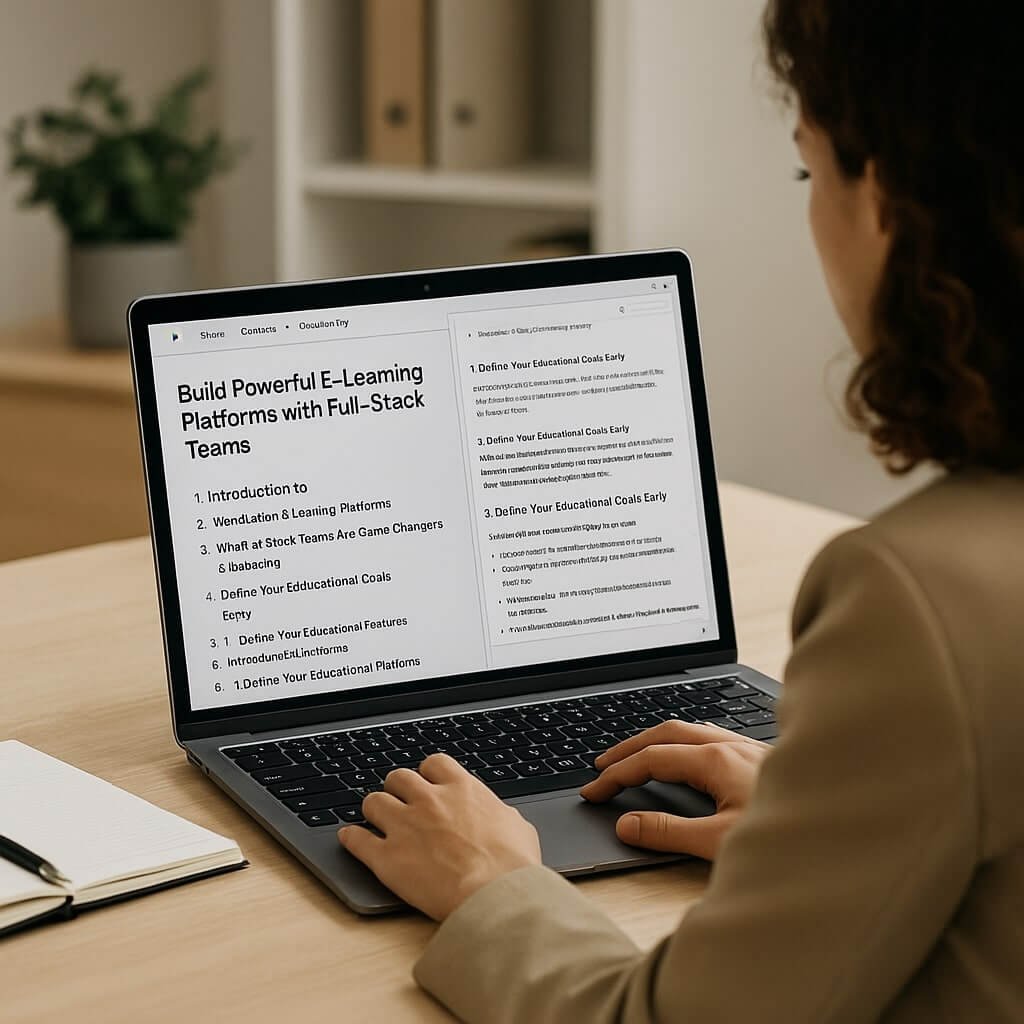The e-learning revolution is transforming the way education is delivered. From corporate training to K–12 online programs, digital platforms now enable dynamic, personalised, and global learning experiences. At the heart of successful platforms are full-stack development teams—professionals capable of handling both front-end and back-end development. Their versatility ensures a seamless experience for learners, instructors, and administrators alike.
E-learning platforms demand not just content delivery but real-time interactions, robust security, mobile compatibility, analytics, and user engagement. This level of complexity is exactly where full-stack teams shine.
Why Full-Stack Teams Are Game-Changers in E-Learning
A full-stack development team brings a well-rounded approach to platform building. With expertise in everything from UI design to database management and server-side logic, they bridge the gap between design and functionality.
Benefits include:
- Faster development cycles
- Cost-effective implementation
- Better team coordination
- Streamlined maintenance and upgrades
They are particularly effective for startups or institutions looking to build custom solutions with limited resources.
1. Define Your Educational Goals Early
Your e-learning platform must be rooted in clear learning objectives. Whether it’s employee upskilling, test preparation, or lifelong learning, your goals will guide every development decision.
Aligning Curriculum with Digital Features
- For skills-based training, integrate coding sandboxes or video demonstrations.
- For academic instruction, build modules with assessments, note-taking features, and timed quizzes.
- For self-paced learning, include bookmarking, lesson progress tracking, and reminders.
Early goal-setting empowers full-stack teams to shape the product roadmap strategically.
2. Choose the Right Tech Stack for Your Platform
Selecting the appropriate technology stack ensures your platform is secure, scalable, and efficient.
Front-End Technologies for Learner Engagement
- React.js or Vue.js for dynamic interfaces
- Bootstrap or Tailwind CSS for responsive design
- Progressive Web Apps (PWAs) for mobile access
Back-End Technologies for Performance & Security
- Node.js, Django, or Ruby on Rails for scalable server logic
- MongoDB, PostgreSQL, or MySQL for robust data storage
- Firebase or AWS Lambda for cloud functions and authentication
Choosing the right stack enables fast load times, secure sessions, and seamless content delivery—all essential for e-learning.
3. Design Intuitive, Accessible UI/UX
User experience can make or break an e-learning platform. A cluttered interface frustrates learners, while an intuitive design increases engagement and retention.
Responsive Design Principles for Learners
- Use grid-based layouts and cards for content
- Ensure readability across devices
- Integrate offline capabilities for mobile users
Accessibility Compliance in Education
- Support keyboard navigation
- Include screen-reader labels and captions
- Adhere to WCAG guidelines
With accessibility, your platform becomes inclusive, reaching a broader user base, including those with disabilities.
4. Implement a Scalable Architecture for Growth
Scalability ensures your platform can handle thousands of users without crashing or slowing down.
Cloud Solutions for E-Learning Platforms
- AWS, Azure, or Google Cloud for dynamic scaling
- Containerization using Docker and Kubernetes for deployment
- Load balancers to distribute traffic evenly
A full-stack team ensures the right architectural decisions are made from the start, avoiding future bottlenecks.
5. Integrate Interactive Tools and Multimedia
Interactivity boosts user engagement, comprehension, and satisfaction.
Real-Time Communication Features
- Live chat and video conferencing via WebRTC or Zoom APIs
- Discussion forums built with Node.js and WebSockets
Gamification and Simulations
- Point systems, badges, and leaderboards
- Interactive simulations using JavaScript libraries
By integrating these tools, your platform becomes more than a course—it becomes an experience.
6. Optimise Performance and Data Handling
Slow loading times, crashes, and data loss erode user trust. Optimisation must be built in from day one.
Caching, Load Balancing & Data Sync
- Use Redis or Memcached for caching
- Implement CDNs for fast content delivery
- Synchronise databases across global regions
Student Data Privacy and Compliance
- Adhere to GDPR, FERPA, or local privacy laws
- Encrypt personal and academic data
- Use secure authentication (OAuth2, JWT)
Proper data handling is not just technical—it’s ethical and legal.
7. Deploy Agile Workflows and Continuous Feedback
The best platforms evolve. Agile development encourages iteration, testing, and continuous learning.
CI/CD Pipelines and Iterative Improvements
- Automate testing and deployment with Jenkins, GitHub Actions, or GitLab CI
- Gather user feedback via built-in surveys or analytics tools
- Adjust features based on user behaviour
Full-stack teams thrive in agile environments, as they can adjust both front-end and back-end features quickly.
FAQs About Full-Stack Teams and E-Learning Platforms
What is a full-stack team in the context of e-learning?
A full-stack team handles both the client-side and server-side aspects of an e-learning platform, ensuring seamless development, maintenance, and performance.
How do I choose the best tech stack for an e-learning site?
Consider factors like scalability, user engagement, security, and budget. Full-stack teams can help you match technologies to your platform goals.
Are full-stack teams suitable for large-scale institutions?
Yes. While they’re cost-effective for startups, full-stack teams also support enterprise-level development when well-structured and supported.
How do I ensure my e-learning platform is accessible?
Incorporate WCAG-compliant design, support assistive technologies, and offer alternative text and captions for media.
What are the best ways to keep learners engaged?
Use gamification, real-time communication, multimedia content, and personalised learning paths.
How often should I update my platform?
With agile methodologies and a CI/CD pipeline, updates can be rolled out continuously based on user feedback and tech changes.
Conclusion: Unlock the Potential of Full-Stack E-Learning
Building a robust e-learning platform takes more than just educational content—it requires a strategic, tech-driven approach. Full-stack teams provide the flexibility, speed, and technical depth needed to develop platforms that engage learners and scale with demand.
By defining clear goals, choosing the right stack, focusing on user experience, and applying agile principles, your team can create a lasting impact in the digital education landscape.






